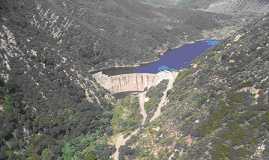Matilija Creek
| Matilija Creek | |
| Arroyo Matilija [1] | |
| River | |
 Matilija Reservoir and Dam | |
| Country | United States of America |
|---|---|
| State | California |
| Tributaries | |
| - left | Middle Fork Matilija Creek, Upper North Fork Matilija Creek, North Fork Matilija Creek |
| - right | Old Man Canyon, Murietta Canyon |
| Source | |
| - location | Santa Ynez Mountains, Santa Barbara County |
| - elevation | 5,200 ft (1,585 m) |
| - coordinates | 34°35′45″N 119°27′31″W / 34.59583°N 119.45861°W |
| Mouth | Ventura River |
| - elevation | 915 ft (279 m) |
| - coordinates | 34°29′06″N 119°18′01″W / 34.48500°N 119.30028°W |
| Length | 18 mi (29 km) |
| Basin | 54.6 sq mi (141 km2) |
| Discharge | for near Matilija Hot Springs |
| - average | 43.3 cu ft/s (1 m3/s) [2] |
| - max | 8,780 cu ft/s (249 m3/s) |
| - min | 0.03 cu ft/s (0 m3/s) |
Matilija Creek (/məˈtɪlɨhɑː/ mə-TIL-i-hah) is a major stream in Ventura County in the U.S. state of California. It joins with North Fork Matilija Creek to form the Ventura River.[3] Many tributaries feed the mostly free flowing, 17.3-mile (27.8 km) creek,[4] which is largely contained in the Matilija Wilderness.
History
Matilija was one of the Chumash rancherias under the jurisdiction of Mission San Buenaventura. The meaning of the Chumash name is unknown.[5][6]
Geography
From its headwaters south of Sespe Creek, the creek flows east and south through a narrow, flat-floored valley. It then turns east and receives the Middle Fork, which flows generally south and west, on the right, then flows east paralleling Forest Road 5N24 before it empties into Matilija Lake (really a reservoir), now mostly a mudflat, on a broad, flat alluvial fan. After exiting the approximately 200-foot (61 m) high dam, the creek turns north and meets the North Fork Matilija Creek;[7] from there on it is called the Ventura River.
The smaller North Fork Matilija Creek flows west and south from its headwaters near Rose Valley, which is the source of Sespe Creek. The creek runs west, paralleling Forest Route 6N31, and receives a small tributary with a roughly fan-shaped drainage basin from the left. It then turns north and cascades through a narrow gorge, then receives a tributary from the left. It then begins to parallel California State Route 33 as it nears the town of Wheeler Springs. It arcs to the east and joins Matilija Creek shortly downstream.
Fed by some perennial springs, despite its location in arid terrain, the creek flows year round, and tends to reach enormous flows in the rainy season.
River modifications
The creek has one dam on it, Matilija Dam, built in 1948 to provide water supply for agricultural and urban uses in Ventura County. When completed, the dam was 190 feet (58 m) high and could impound more than 7,000 acre feet (0.0086 km3) of water. The reservoir has now almost completely filled with sediment, rendering it nearly useless. The dam was notched to reduce its height twice in the late 20th century, in order to allow some of the accumulated sediment to flow downstream. It is currently slated for removal.
Ecology

The name of the Matilija poppy (Romneya) is taken from the Matilija creek canyon.[5] The Matilija Dam was constructed in 1947 on lower Matilija Creek for the purpose of supplying water storage and flood control, blocking access of anadromous Steelhead trout (Oncorhynchus mykiss) to over ten miles of upstream spawning areas. Historically 5,000 steelhead trout used the upper Matilija basin. The Robles Diversion Dam on the Ventura River downstream posed a barrier to trout migration until a $6 million fish ladder was constructed in 2006.[8] Recent genetic analysis of the steelhead in Matilija Creek (both above and below Matilija Dam) has shown them to be of native and not hatchery stocks.[9]
See also
- Rindge Dam, which Malibu Creek filled with sediment like Matilija Dam
- Riparian zone restoration
References
- ↑ Ventura County Centennial. Ventura County Historical Society Quarterly. 1972.
- ↑ "USGS Gage #11114495 on Matilija Creek near Reservoir, near Matilija Hot Springs, CA: Water-Data Report 2009". National Water Information System. U.S. Geological Survey. 2002-present. Retrieved 2011-01-01.
- ↑ U.S. Geological Survey Geographic Names Information System: Matilija Creek
- ↑ U.S. Geological Survey. National Hydrography Dataset high-resolution flowline data. The National Map, accessed March 16, 2011
- ↑ 5.0 5.1 Erwin G. Gudde, William Bright (2004). California Place Names: The Origin and Etymology of Current Geographical Names. University of California Press. p. 231. ISBN 978-0-520-24217-3. Retrieved 2011-01-29.
- ↑ Durham, David L. (1998). California's Geographic Names: A Gazetteer of Historic and Modern Names of the State. Quill Driver Books. ISBN 978-1-884995-14-9.
- ↑ U.S. Geological Survey Geographic Names Information System: North Fork Matilija Creek
- ↑ "Efforts to Revive Southern California’s Steelhead Fish Population and Recreational Fishing Industry". NOAA Fisheries. Retrieved 2011-01-29.
- ↑ Anthony J. Clemento, Eric C. Anderson, David Boughton, Derek Girman, John Carlos Garza (2009). "Population genetic structure and ancestry of Oncorhynchus mykiss populations above and below dams in south-central California". Conservation Genetics: 1321–1336. Retrieved 2011-06-11.